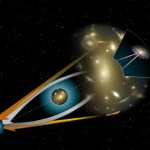Physical Sciences
“I followed him at the time and thought he was hysterical. He was the first serial killer, a new kettle of fish, because we didn't have the detection techniques in those days.” -Matthew Bright
You can't get mad at a team for trying the improbable, hoping that nature cooperates. Some of the most famous discoveries of all time have come about thanks to nothing more than mere serendipity, and so if we can test something at low-cost with an insanely high reward, we tend to go for it. Believe it or not, that's the mindset that's driving the direct searches for dark matter.
Image credit:…
Two papers with a similar theme crossed my social media feeds in the last couple of days. You might think this is just a weird coincidence, but I'm choosing to take it as a sign to write about them for the blog.
So, what are these papers, and what's the theme? One is the final publication of some results I saw at DAMOP and alluded to back in June, and the other is from this post by Doug Natelson. Both look at the transition from few-body to many-body physics.
And this is interesting, why? I mean, isn't it obvious that you just add some more bodies? OK, I guess that does need a little more…
"Controversy is only dreaded by the advocates of error." -Benjamin Rush
Welcome back to another Messier Monday! Each week, we take an in-depth look at one of the 110 deep-sky wonders of the Messier Catalogue, from distant galaxies to nearby star clusters, from nebulous star factories to ancient globular bunches, and from stellar remnants to the rare-but-interesting anomalies. There are only three such anomalous entries out of all 110 Messier objects, and today provides us with a fantastic opportunity to take an in-depth look at one of them.
Image credit: The Messier Objects by Alistair Symon…
Through some kind of weird synchronicity, the title question came up twice yesterday, once in a comment to my TED@NYC talk post, and the second time on Twitter, in a conversation with a person whose account is protected, thus rendering it un-link-able. Trust me.
The question is one of those things that you don't necessarily think about right off-- of course an atom is a particle!-- but once it gets brought up, you realize it's a little subtle. Because, after all, while electrons and photons are fundamental particles, with no internal structure, atoms are made of smaller things. But somehow we…
Over the weekend, before the whole Scientific America debacle blew up, Ben Lillie tweeted:
Looking for science news pegs that aren't "a paper was published." Good examples? #ScioOcean #scionew
— Ben Lillie (@BenLillie) October 12, 2013
This is, of course, a familiar problem to a lot of people who care about the public dissemination of science. The need for a good "hook" is a constant issue, because without one, you can't get anyone to pick up a story. And you can't let one get past, either, leading to a frantic scramble whenever anything happens that has the slightest connection to science…
I'm sure I've done more than enough wibbling about TED for this week, but the only major physics story at the moment involved the Higgs boson, and I'm thoroughly sick of that. So let's talk about Malcolm Gladwell and journosplaining.
Gladwell has a new book out, David and Goliath that from all reports is pretty much exactly what you expect from a Malcolm Gladwell book. I greatly enjoyed the digested read by John Crace in the Guardian. Among the many bad reviews of this were a trio by my colleague at Union, Christopher Chabris-- first a paywalled review in the Wall Street Journal, then a post…
There was a great big New York Times article on women in science this week, which prompted no end of discussion. (I also highly recommend Bee's response at Backreaction.) It's built around the personal story of the author, Eileen Pollack, a physics major at Yale who decided not to go to grad school, and her story is compellingly told, providing a nice frame to her investigation of the question of why there continue to be so few women in the sciences.
Pollack comes out very much in favor of the notion that many women choose not to go to graduate school in the sciences because they don't…
In medicine, particularly oncology, it's often the little things that matter. Sometimes, however, the "little things" aren't actually little; they just seem that way. I was reminded of this by a story that was circulating a couple of weeks ago in the national media, often under titles like “Obese cancer patients often shorted on chemo doses”, ”Are obese people with cancer getting chemotherapy doses too small for them?”, and “Obese Cancer Patients Not Getting Full Doses of Chemotherapy Drugs”. It's also interesting to me because it stands in marked contrast to something I've written about a…
In a comment to yesterday's post about the liberal arts, Eric Lund makes a good point:
The best argument I have ever heard for doing scholarship in literature and other such fields is that some people find it fun.
I single this out as a good point not because I want to sneer at the literary disciplines, but because with a little re-wording, this could apply to just about anything. The best reason for studying any academic subject is because it's fun.
This is, as I alluded to in a later comment of my own, a significant source of tension for Delbanco's book and a lot of other arguments about…
The JCC day care is closed today for one of the fall cluster of Jewish holidays, which means I'm spending the morning with The Pip before Kate comes home to take the afternoon shift so I can teach my class. Thus, this is more of a tab clearance sort of exercise than a thoughtful examination of the underlying issues. But having spent a bunch of time in the recent past on gender gaps of various sorts, these are some recent links that struck me as interesting enough to pass along.
-- Via Crooked Timber, Anca Gheaus offers cheers for being the "token" woman at academic conferences. This is mostly…
A google hangout this afternoon:
"Today, September 18, 2:00 PM
SETI Institute researchers Jill Tarter and Franck Marchis (host & moderator) will hangout with Jason Wright, professor of astronomy at Penn State, Matt Povich, professor of astronomy at Cal Poly Pomona and Freeman Dyson, theoretical physicist and mathematician at the Institute for Advance Study.
These scientists will discuss the potential for the WISE telescope to detect extraterrestrial super-civilizations that acquired a large energy supply by building a mega-structure to harvest the energy of their star("Dyson Sphere") or…
I got a strange phone call today, from a fellow who was very polite, so I was polite in return, but it was weird — he kept asking me strange questions about the energy involved in breaking up supercontinents, and how much water could be stored under a supercontinent (which had me suspicious right there), and he was also complaining about how none of the geologists anywhere ever seemed to study this stuff. I told him repeatedly that what he needed to do was talk to a geophysicist, which I wasn't, and that I really couldn't help him. He had a few very basic question about plate tectonics that I…
To say that I haven't been much of a fan of the National Center for Complementary and Alternative Medicine (NCCAM) throughout the years is a gross understatement. If you want to see the depths of my—shall we say?—lack of enthusiasm for NCCAM, feel free to type "NCCAM" in the search box of this blog and in particular look for posts that have "NCCAM" somewhere in their titles. It won't take you long to find posts by yours truly with titles as awesome as NCCAM: I say we take off and nuke the entire center from orbit. It’s the only way to be sure and NCCAM in the news: Why does it still exist?…
This is probably the last trip into the cold atom toolbox, unless I think of something else while I'm writing it. But don't make the mistake of assuming it's an afterthought-- far from it. In some ways, today's topic is the most important, because it covers the ways that we study the atoms once we have them trapped and cooled.
What do you mean? They're atoms, not Higgs bosons of something. You just... stick in a thermometer, or weigh them, or something... OK, actually, I have no idea. They're atoms, yes, but at ultra-low temperatures and in very small numbers. You can't bring them into…
In our last installment of the cold-atom toolbox series, we talked about why you need magnetic traps to get to really ultra-cold samples-- because the light scattering involved in laser cooling limits you to a temperature that's too high for making Bose-Einstein condensation (BEC). This time out, we'll talk about how you actually get to those ultra-cold temperatures.
What do you mean? I assumed it was just part of the trapping process? No, because the forces involved in magnetic trapping are like those involved in optical dipole traps. In physics jargon, they're "conservative" forces, which…
"It is no good to try to stop knowledge from going forward. Ignorance is never better than knowledge." -Enrico Fermi
As you probably know, the Large Hadron Collider -- site of discovery of the last fundamental particle in the Standard Model, the Higgs Boson -- is the most energetic particle accelerator in the history of humankind. When the upgrades it's currently undergoing are complete, it will reach collision energies of 14 TeV.
Image credit: CERN / LHC, add-on created by http://www.panglosstech.com/.
The way this happens is that protons are circulated in a giant ring, underground, that'…
We're getting toward the end of the cold-atom technologies in my original list, but that doesn't mean we're scraping the bottom of the barrel. On the contrary, the remaining tools are among the most important for producing and studying truly ultra-cold atoms.
Wait, isn't what we've been talking about cold enough? There is, as always, more art than science in the naming of categories of things. "Cold" and "ultra-cold" get thrown around a lot in this business, and the dividing line isn't quite clear. Very roughly speaking, most people these days seem to use "cold" for the microkelving scale…
There was some buzz Thursday about a poll showing that 40% of white people don't have any friends of a different race. Ipsos/Reuters include a spiffy "data explorer" where you can make graphs like the one above. It does not appear to provide an easy way to get at the actual wording of the question, which is kind of crucial, and thus renders most of the stories about it too vague to take all that seriously.
Of course, this is somewhat reminiscent of the gender bias story from a couple of weeks ago, where it was shown that single-gender physics departments are not a clear indication of sexism.…
When I heard that Steven Pinker had written a new piece decrying the accusations of scientism, I was anxious to read it. "Scientism" is a blunt instrument that gets swung in my direction often enough; I consider it entirely inappropriate in almost every case I hear it used.
Here's the thing: when I say that there is no evidence for a god, that there's no sign that there is a single specific thing this imagined being has done, I am not unfairly asking people to adopt the protocols of science — I am expecting to judge by their own standards and expectations. They are praying to Jesus in the…
I spent an hour or so on Skype with a former student on Tuesday, talking about how physics is done in the CMS collaboration at the Large Hadron Collider. It's always fascinating to get a look at a completely different way of doing science-- as I said when I explained my questions, the longest author list in my publication history doesn't break double digits. (I thought there was a conference proceedings with my name on it that got up to 11 authors, but the longest list ADS shows is only eight). It was a really interesting conversation, as was my other Skype interview with a CMS physicist.…









